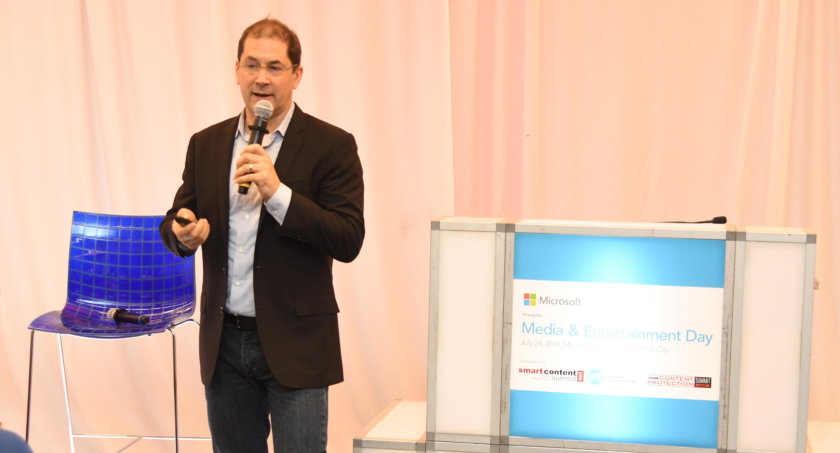Connections

MarkLogic Exec: Companies Should Use the Right Data Pattern to Unlock Smart Content’s Power
Story Highlights
NEW YORK – It’s important for media and other companies to use the right data pattern if they want to truly take advantage of the power of smart content, according to Matt Turner, MarkLogic CTO-media and manufacturing.
“We’re working in a world where there is a knowledge about new ways of storing data,” yet there’s still a “great deal of practice around the traditional rows and columns approach” of storing data, he said July 24 during a session called “Unlock the Power of Smart Content with the Right (Data) Pattern” at the Smart Content Summit East event, part of the Media & Entertainment (M&E) Day at the Microsoft Conference Center.
The 2018 M&E Day also included Content Protection Summit East and Entertainment Production in the Cloud (EPIC) conference tracks, providing M&E technology teams valuable insights into the creation, production, distribution, security and analysis of content.
An over-reliance on traditional ways of storing content data is the main reason why we often get restricted data that isn’t very useful, Turner told the summit.
“Everybody needs access to the data but it’s in these siloes — it’s in systems that are purpose-built for those particular systems” and, therefore, are only useful in one specific area, he said.
Instead of the traditional rows and columns approach to storing data, more “flexible schemas” should be used – and that’s what MarkLogic has been using with several projects he cited during the presentation, noting that the goal is to “bring together the data, link it and then make it available.”
“We’ve been at this for a while,” he noted, recalling an industry meeting in Los Angeles about smart content four years ago.
The “starting premise” at the time was, he explained: “Let’s not just look at the content. We all know the content – and at that time particularly we had gotten over the big hump of the fact that ‘OK, we’re talking about digital files here.’ We’re talking about lots and lots of data that you need to describe those digital files. But let’s take a step back. Let’s look at the data that’s getting created as you begin the process – the planning, the investment. Let’s look at what actually happens in the setup – getting it all together, getting the project started. Let’s look at actually what happens on the set. Let’s begin to have that conversation about data in that context. And then … we’re into the distribution, where a lot of the focus was. But let’s not forget that there is a life afterwards and, in fact, the life afterwards is not just a big safe where you lock everything. The life afterwards is, in fact, the content and the value of it.”
Today, however, in terms of leveraging content data, “we all have a lot of work to do, I think,” he said.
Creating data hubs and “bringing them together is actually critically important for almost any business,” he said, noting MarkLogic clients have included various media companies, as well as Airbus and Chevron.
Smart content projects that MarkLogic has worked on included ones for the BBC and NBC’s “Saturday Night Live” in recent years, he said. The latter project “didn’t just take the data or the metadata — it actually made a whole new set of data to connect the fans’ view of the show to the content,” he told attendees.
He also recalled the “data threat” experienced during the filming of the independent film “The Suitcase” that MarkLogic collaborated on with the Entertainment Technology Center at the University of Southern California. That was a “cloud-first” production in which data was collected as it was generated, he said, adding: “Because of that choke point in the cloud, the data was mapped out and made available and we were bringing it together and creating a canonical set of data from the actual production data – not having people retype in things like the production staff, things like the actual character list, the set list, the scenes that were actually shot and the information behind the scenes was brought forward and collected as data.” That was a “great experiment and we’re nowhere done with this,” he said.
Turner left attendees with this advice that concluded his presentation: “Create a data hub, link the data together, use those different data models and that’s the way to get smart.”
The 2018 Media & Entertainment Day was presented by Microsoft, with sponsorship from IBM Watson Media, Amazon Web Services, IBM, LiveTiles, Microsoft Azure, NAGRA, NeuLion, Ooyala, EIDR, GrayMeta, MarkLogic, Qumulo, Avid, Cloudian, SoftServe and TiVo. The event was produced by the Media & Entertainment Services Alliance (MESA), the Content Delivery & Security Association (CDSA), the Hollywood IT Society (HITS) and the Smart Content Council.
Click here for audio of Turner’s presentation or here (https://www.mesaonline.org/wp-content/uploads/2018/03/Unlock-the-Power-of-Smart-Content-with-the-Right-Data-Pattern-.pdf) for the slide deck.









